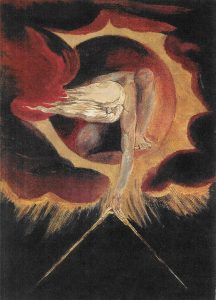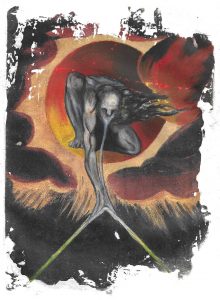William Blake’s ‘Ancient of Days’ was first published in 1794 as the front piece to his book ‘Europe a Prophecy’. The work encapsulates Blake as an artist and his religious beliefs whilst also providing a commentary on the French Revolution and British politics of the 1790’s. Ever since a young age Blake had visions of celestial beings and would regularly converse with them. He once stated that his artwork was more popular in the heavenly world he observed. The work he produced depicts the views and beliefs of his own unique religion; the religion of his invention was predominately Christian but also included inspiration from other sources such as Norse and Greek mythology.
I chose to appropriate this piece of work as a continuation of one of my personal projects. I was particularly interested in the dark and effective use of colours within the work and the significance behind the work. In the last verses of ‘Europe a Prophecy’ Blake describes the coming of the apocalypse. I was considering the ideas of what would happen if the book had been written in a post apocalypse dystopian state how would the work have been changed or altered, who would represent god and what would the meaning of apocalypse be after it had already come to pass.
I chose to start the work with an image transfer in order to lighten the work to create an easier surface to work with. God was then reworked to be deformed and mutilated, whilst having a gas mask grown into his face. I felt I needed to darken the image and age it suitably to recreate the depth seen in the original work for completion. The final outcome confers the all the meaning of the original work however brings the context forwards in time leading the viewer to question whether the work is still relevant today.
Bibliography
Blunt, A. (1974). The art of William Blake. New York: Harper & Row, p.353.


